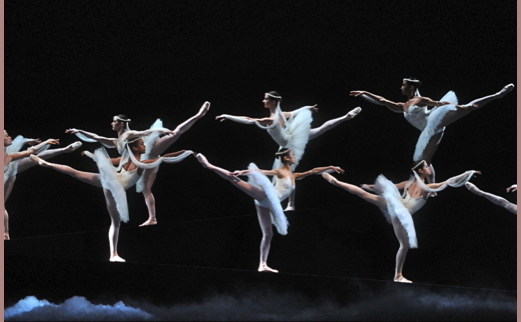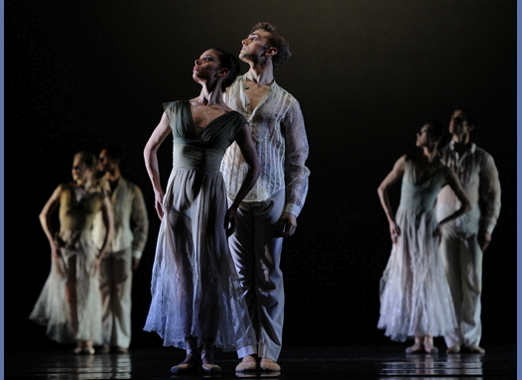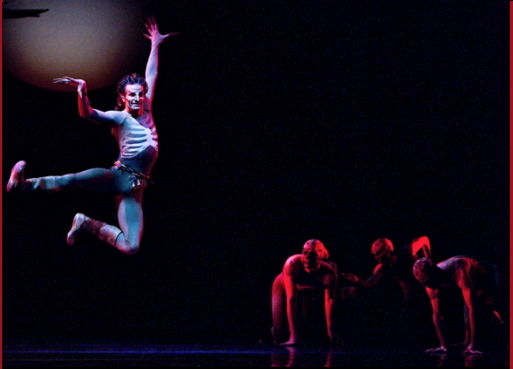Program 3 at San Francisco Ballet is a rare trio of works that explores themes of longing, unfulfilled love and connecting with the hereafter or the totally other. First on the bill is "The Kingdom of the Shades" from Act II of the very seldom produced La Bayadère. Based on the original choreography of Marius Petipa, the segment is regarded as one of the most glorious in all of classical ballet. In fact, it is an Olympian-type challenge. And for the occasion, the company brought in legendary ballerina and choreographer Natalia Makarova -- the keeper of the flame -- to stage the scene and to imbue the dancers with its particular discipline and power. The opening night performance was elegant and refreshing. Conducted by Martin West, this portion of the score by Ludwig Minkus tugs at the heart in the same manner as the final scenes of Giselle and Swan Lake. The difference is that the action of the moment is an opium-induced hallucination.
The dreamer/user is Solor (Davit Karapetyan), a warrior filled with sorrow over the death of his love, Nikia (Yuan Yuan Tan), an Indian temple dancer. His vaporous head trip begins with a series of entrances by 24 women from the corps de ballet, each of whom represent the image of Nikia. The illusion is a variation on the visual effect of a mise en abyme -- the repeating reflections one sees when standing between two mirrors. From stage left, a single dancer emerges on a high and descending platform. She moves into an arabesque position, raises her arms and steps forward. She is followed by the next dancer who "mirrors" the pattern, starting on the opposite leg. The line continues to grow and the descending path reverses direction. As the two lines pass each other and the arabesque is in full position, the stage picture suggests an interlocking chain. Reaching the stage floor, the leader again reverses direction and continues to advance as yet another dancer enters at the top. The complete descent and the ensemble's positioning into parallel rows facing the audience lasts a bit more than four minutes. For us and the beguiled warrior, the effect is mind-blowing. Like the drug, it creates a hunger for more. When will we see the complete ballet?
The second production, Ghosts, received its world premiere at SF Ballet in 2010. The collaborative work by composer C.F. Kip Winger and choreographer Christopher Wheeldon is a compelling take on one of the classical world's most entrancing advantages -- dancing with the dead.
Wheeldon's phantoms move about in a space that is dominated by a large piece of twisted wreckage that hovers above them stage right. Whatever it is to them, however we try to interpret its inclusion -- the indeterminate gnarled object occasionally turns and rolls. Is it in a state of perpetual free-fall? Perhaps this is the site of a sudden disaster, where collected spirits are consigned to a never-ending loop of enigma and bewilderment. Winger's first movement, Misterioso, includes a lilting phrase for solo violin that ends abruptly, drifting off-pitch into nothingness. During the second movement, Largamente, the sound of a piano glimmers like rain through the broad strokes and moody tones of the string section. Set as a pas de deux and danced by Maria Kochetkova and Vitor Luiz, Wheeldon intertwines something like sentiment with tension and resistance, where suggestions of knowing are countered by detachment. The third movement, Adagio, plays with melancholy, nostalgia and interrupted expectation.
Yuri Possokhov's Firebird was given its world premiere by San Francisco Ballet in 2007. The strength of the production and its proven appeal rests in its simplicity and the well-defined nature of the characters. This season's opening night performance featured Sarah Van Patten as the title character, Tiit Helimets and Sasha De Sola as the Prince and Princess, and Pascal Molat in the delectable role of the evil Kaschei. In contrast to its companion pieces in Program 3, the anthropomorphic component within fairytales provides an open gateway to the impossible. Possokhov removes extraneous opulence from his production and grants the hallowed Russian story a new life with his near comic book/cartoon approach. His magic touch sweetens the relationship of the enchanted bird with her captor. Each of them owes their life and freedom to the other. The heartbroken firebird learns and survives this human thing called love.


